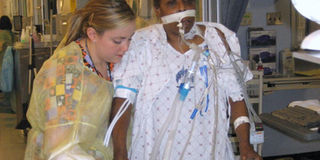Physiotherapy important for patients in ICU

Rehabilitation delivered by the physiotherapist is tailored to patient needs and depends on conscious state, psychological status and physical strength. stock PHOTO
What you need to know:
- Although it is not easy, physiotherapy helps patients recover from illness and chronic disease, injury and age related conditions, among others.
A larger proportion of critically ill patients admitted in the Intensive Care Unit (ICU) are usually immobile. Dr Gum Ephrem Grace, an anaesthesiologist, says immobility in itself is a disease and can cause complications in a critically ill patient.
The doctor says immobility causes poor lung expansion and poor lung function. This is normally caused by to a large extent, muscle weakness and or problems in the lung caused by the patient purely being immobile.
Circulation
According to Dr Grace, immobility increases the chance of formation of blood clot especially in the deep veins of the limbs. These blood clot may break away and start flowing in the circulatory system forming an embolus which end up in the lung vessels forming pulmonary embolus (PE). When a PE is big enough, that it blocks a large portion of the lung, it causes death in a very short time
It also causes increased water retention in the body; edema. It is visibly seen as body swelling and although the internal retention is unseen. Immobility also causes increased workload on the heart and failure of the circulation system to effectively control blood pressure
Skin
If a patient spent very long in one position, the dependent part of the body tends to have reduced blood flow thereby causing cell death in that tissue, usually the skin and the tissues underlying the skin. This will cause a wound called pressure sores or pressure wound.
Endocrine/hormone system
The process of handling glucose and the hormones that controls its metabolism is also deranged in an immobile patient leading to what is called glucose intolerance.
Well-fed immobile patients will gain weight not only because of lack of physical excise but also due to derangement in the hormones that control its deposition in the body.
Salt and water retention occurs in an immobile patient. It is seen as body swelling visibly, and in the internal organs too.
Muscle and skeletal system
There is loss of muscle mass due to disuse causing associated weakness/ loss of power. That is coupled with loss of bone mass due to loss of its mineral caused by disuse in an immobile patient. Joints of an ICU patient will become stiff if nothing is done.
Genital and urinary system
Difficulty in passing urine and control will also occur in both men and women but more in men. It will then accumulate increasing the chance of Urinary Tract infection (UTI) in an immobile patient.
Digestive system
Intestinal movement is reduced in an immobile patient leading to food in the stomach flowing back into the oesophagus and some time as far back as the mouth. This may lead to food particles getting into lungs, creating a condition known as Aspiration pneumonia.
Slowed gut movement or complete stasis may lead to nausea and vomiting, poor appétit, constipation and malnutrition.
Physiotherapy
Quraish Golooba, a physiotherapist with Victoria Hospital, says the above complications can be prevented to a large extent by performing sets of prescribed exercises. He mentions that there two types exercises; active and passive.
Passive excises; these are sets of excises performed on the patient, by preferably the physiotherapist, though in a resource poor setting, the medical team, in the early days of ICU stay when the patient is still either deeply comatose and the patient is unable to participate.
Active excises are sets of excises performed by the physiotherapist and or the medical team with participation of the patient. These include: transfers from bed to chair, from lying to sitting, sitting at the edge of the bed, sitting to standing, putting a patient in standing frames or even walking.
Golooba intimates that exercises on an ICU patient is a big part of the rehabilitation plan for a critically ill patient and it should be started as early as possible to reduce the possibility of occurrence of the above listed complications of immobility. This will improve the prognosis of the patient and also improve the quality of life after a critical illness.




